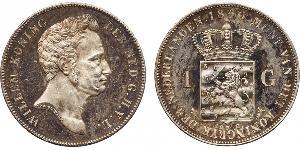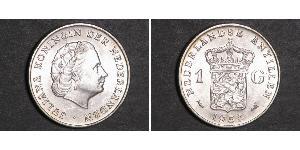1 Gulden Netherlands Silver William I of the Netherlands (1772 - 1843)
1840, Netherlands, William I. Scarce Silver 1 Gulden (100 Cents) Coin. 1-Year Type!
Mintage: 99,320 pcs. Mint year: 1840 (1-year type!) Reference: KM-65 ($150 in VF!) Denomination: 1 Gulden (Rijksdaalder) Condition: Minor deposits in reverse, scatterec circulation marks, otherwise about XF! Mint Place: Utrecht (privy marks: fleur de lis & caduceus) Material: Silver (.893) Diameter: 28mm Weight: 9.9gm
Obverse: Bust of William I Frederick right. Designer’s signature (J.P. SCHOUBERG F.) on bust truncation Legend: WILLEM KONING – DER NED. G. H. V. L.
Reverse: Crowned shield of the Netherlands (crowned lion with thunderbolts and sword in paws), flanked by value (1-G). Comment: Privy marks (fleur de lis / caduceus) of the Utrech mint at sides, cent value (100 C.) below! Legend: MUNT VAN HET KONINGRYK DER NEDERLANDEN . 1840 .
William I (Willem Frederik, Prince of Orange-Nassau; 24 August 1772 – 12 December 1843) was a Prince of Orange and the first King of the Netherlands and Grand Duke of Luxembourg.
In Germany, he was ruler (as Fürst) of the Principality of Nassau-Orange-Fulda from 1803 until 1806 and of the Principality of Orange-Nassau in the year 1806 and from 1813 until 1815. In 1813 he proclaimed himself ‘Sovereign Prince’ of the “United Netherlands.” He proclaimed himself King of the Netherlands and Duke of Luxembourg on 16 March 1815. In the same year on 9 June William I became also the Grand Duke of Luxembourg and after 1839 he was furthermore the Duke of Limburg. After his abdication in 1840 he styled himself King William Frederick, Count of Nassau.
King William I’s parents were the last stadtholder William V, Prince of Orange and his wife Wilhelmina of Prussia. Until 1813, William was known as William VI, Prince of Nassau-Dietz, Prince of Orange. In Berlin on 1 October 1791, William married his first cousin (Frederica Louisa) Wilhelmina, born in Potsdam. She was the daughter of King Frederick William II of Prussia. After Wilhelmina died in 1837, William married Countess Henriette d’Oultremont de Wégimont (Maastricht, 28 February 1792 – Schloss Rahe, 26 October 1864), created Countess of Nassau, on 17 February 1841 in Berlin. This was a morganatic marriage. Two years later, William died.
William V was hereditary stadtholder when the Republic of the Seven United Provinces was invaded by the French Revolutionary armies in 1794. In January 1795 he fled with his son to England. Unlike his father, who gave his people permission to collaborate with the French[citation needed], William was a strong personality and he tried to regain the Republic.
In 1799, William landed in the current North Holland as part of an Anglo-Russian invasion. The local Dutch population was not pleased with the arrival of the prince. Some local Orangists were even executed. After several minor battles he was forced to leave the country again after the Convention of Alkmaar. Napoleon Bonaparte gave him some small German principalities as indemnities for the lost territories. These principalities were confiscated when Napoleon invaded Germany (1806) and William supported his Prussian relatives. He succeeded his father as prince of Orange later that year, after William V’s death.
After Napoleon’s defeat at Leipzig (October, 1813), the French troops retreated to France. A provisional government was formed under the lead of some former Patriots who recalled William, in contrast to their 1785 rebellion. In their view, it was taken for granted that William would have to head any new regime, and it would be better in the long term for the Dutch to restore him themselves. The Dutch population was pleased with the departure of the French, who had ruined the Dutch economy, and this time welcomed the prince.
After having been invited by the Driemanschap (Triumvirate) of 1813, on 30 November 1813 William disembarked HMS Warrior and landed at Scheveningen beach, only a few metres from the place where he had left the country with his father eighteen years previously, and on 6 December the provisional government offered him the title of King. William refused, instead proclaiming himself “sovereign prince”. He also wanted the rights of the people to be guaranteed by “a wise constitution”.
The constitution offered William extensive (almost absolute) powers. Ministers were only responsible to him, while a two-chambered parliament (the States-General) exercised only limited power. He was inaugurated as sovereign prince in the New Church in Amsterdam. In 1814 he gained sovereignty over the whole of the Low Countries.
Feeling threatened by Napoleon, who had escaped from Elba, William proclaimed himself King of the United Kingdom of the Netherlands on 16 March 1815 at the urging of the powers gathered at the Congress of Vienna. His son, the future king William II, fought as a commander at the Battle of Waterloo. After Napoleon had been sent into exile, William adopted a new constitution which included much of the old constitution, such as extensive royal powers.
He was the 876th Knight of the Order of the Golden Fleece in Spain and the 648th Knight of the Order of the Garter in 1814.
(1365 X 649pixels, file size: ~188K)
Posted by: anonymous 2017-02-24
CoinWorldTV 1840, Netherlands, William I. Scarce Silver 1 Gulden (100 Cents) Coin. 1-Year Type! Mintage: 99,320 pcs. Mint year: 1840 (1-year type!) Reference: KM-65 ($150 in VF!) Denomination: 1 Gulden (Rijksdaalder) Condition: Minor deposits in reverse, scatterec circulation mar ...
(1000 X 501pixels, file size: ~150K)
Posted by: anonymous 2015-12-08
Ausländische Münzen und Medaillen Niederlande-Königreich Gulden 1840. K.M. 65. Berieben, Polierte Platte
(1200 X 583pixels, file size: ~261K)
Posted by: anonymous 2015-08-21
WORLD COINS, NETHERLANDS Ki ngdom of the Netherlands. Willem I (1815-1840). Proof Silver Gulden, 1840, 9.98g (Sch 278; KM 65). Lacquered, light marks and scuffs, otherwise good extremely fine with much lustre. Rare. $ 1,200
1/12 Anna British Raj (1858-1947) Copper George V of the Uni ...
group has 6 coins / 1 prices
⇑












-300-150-02B_AAEB7QEAAAElzZdzfAQA.jpg)






